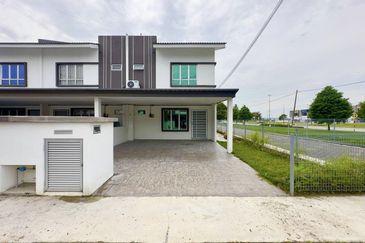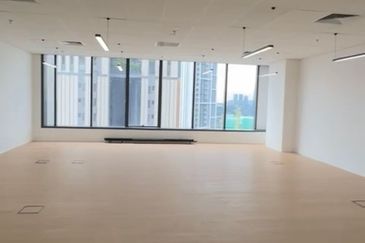
BEIJING (April 29): Tun Dr Mahathir Mohamad had to wrap himself up in a long coat with a scarf pulled tight around his neck to keep warm when he arrived last Wednesday night to a rainy and chilly Beijing — with the temperature hitting the low teens in Celcius — despite it being the middle of spring in the Chinese capital city.
The cold weather that greeted him, however ,was quite a contrast to the warm welcome that the host of the Second Belt and Road Forum (BRF) extended to the 93-year-old.
This was evidenced by how Dr Mahathir was arranged to deliver a keynote address at the opening ceremony of the BRF. He was the only Asean leader who spoke at the opening, and the first Malaysian prime minister to have the honour. In a group photo of all the country leaders who attended the BRF, he, together with his wife Tun Dr Siti Hasmah Mohamad Ali, was placed right in the front row, just a few places to the left of Chinese President Xi Jinping.
In his meeting with Dr Mahathir, Xi highlighted that China was the first country outside of Asean that the prime minster went to on his first official visit last year. The Chinese leader saw this as Malaysia’s intention to continue and further strengthen its diplomatic ties with China.
More importantly, Dr Mahathir told the Malaysian media before he headed home yesterday that the new government now has a better understanding of China’s Belt and Road Initiative (BRI), saying it is not a plan by China to “dominate” other countries. He also acknowledged that there was a misperception of BRI previously, mainly because many developed nations had initiated alliances or partnerships under the name of promoting free trade, which more often than not ended up with the developed countries calling the shots, while developing nations’ interest was not prioritised.
Dr Mahathir has made it clear that Malaysia is supportive of BRI as this cooperation gives equal treatment to all participating countries, regardless of the size of the country’s economy and population.
Dr Mahathir was also chauffered around Beijing in the most expensive bullet-proof limo — the Hongqi L5 — and then to the Yangqi lake, where the 36 world leaders, such as Russian President Vladimir Putin, Singapore’s Prime Minister Lee Hsien Loong and the Sultan of Brunei Darussalam, Sultan Hassanal Bolkiah, gathered for a roundtable dialogue.
Interestingly, his entourage, including six ministers — such as Transport Minister Anthony Loke and Housing and Local Government Minister Zuraida Kamaruddin, and Kedah Menteri Besar Datuk Seri Mukhzri Mahathir — travelled around in a 20-seater van. This could be a cost-saving measure taken by Malaysia and was a vast difference to how the delegates from the United Arab Emirates, who travelled in a long line of Mercedes-Benz behind their leader, went around Beijing.
This is Dr Mahathir’s second trip to China since the change of government in May last year. Members of the delegation who joined the prime minister on both his trips have remarked that the atmosphere this time was much friendlier than when the two countries’ leaders met earlier.
Notably, China’s top three leaders — Xi, Premier Li Keqiang and the chairman of the Standing Committee of the National People’s Congress Li Zhanshu — made time to meet Dr Mahathir, whom they had just shared handshakes with eight months ago in August.
However, if the number of contracts signed is the yardstick by which the prime minister’s trip has to be judged, then detractors will likely say this has not been a fruitful trip. They may even say his trip this round was smoothened by the revival of the East Coast Rail Link (ECRL), which some see as a form of compromise with the superpower.
Only three documents were signed between the two nations this time — namely the framework agreement to reinstate the revival of the Bandar Malaysia project between the Malaysian government and the state-owned China Railway Group Ltd; a memorandum of understanding (MoU) for the development of the industrial park and logistic hub along the ECRL; and the MoU to enhance palm oil trades and investment in Malaysian palm oil-based downstream business, like biodiesel.
Under the MoU related to palm oil, China has committed to importing a minimum of 1.9 million tonnes of palm oil from Malaysia over five years, starting this year. While analysts have commented that the impact of this MoU may not be significant, those at the negotiation table told The Edge Financial Daily that this at least shows China is keen to import palm oil from Malaysia.
Apart from high-level meetings, another highlight was the RM1.88 billion loan that China Construction Bank (CCB) — one of the four biggest state-owned banks in China — granted to Proton Holdings Bhd.
Dr Mahathir witnessed the exchange of the loan agreement between Proton and CCB with a pleased grin on his face throughout the ceremony. With the loan financing, Proton now has the funds for its research and development.
On the last day of his trip here, he told Malaysian media that this had been a successful trip and that both countries have now gained a better understanding of each other’s situation and needs, for example Malaysia’s debt problems and tight fiscal position.
When he met Li, he also said that Malaysia wanted to strengthen its diplomatic ties with China in a “tangible way”, quickly followed by an example of how, if each Chinese consumes one spoonful of palm oil a day, Malaysia will be rich.
Ultimately, whether this trip is truly a successful one, the palm oil export figures will tell eventually. The same can be seen from the multiplier effects — or the lack of it should that be the case — from the mega ECRL project that has now been resumed.
This article first appeared in The Edge Financial Daily, on April 29, 2019.

























